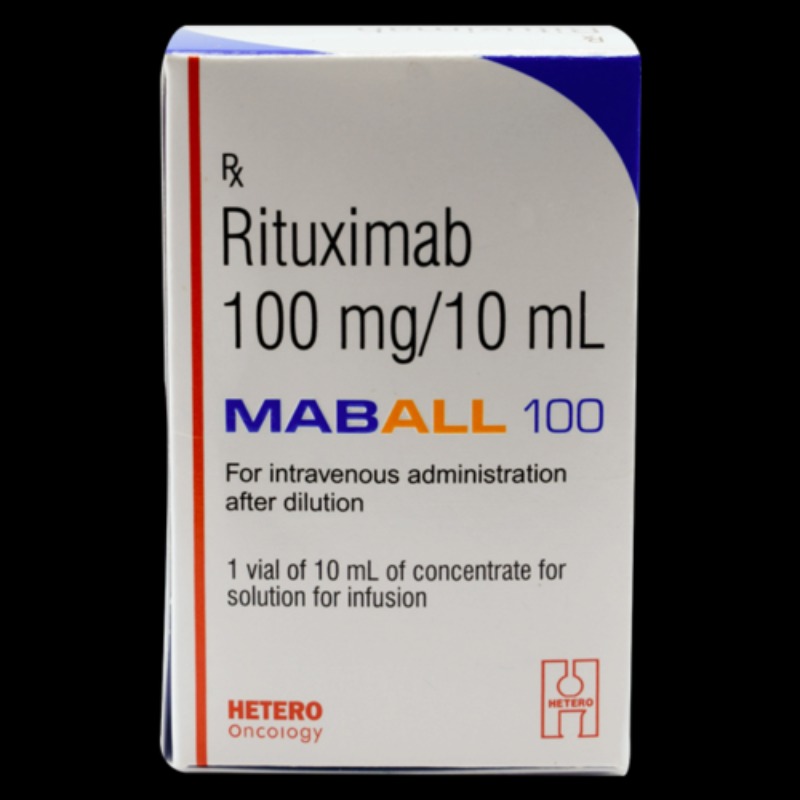DESCRIPTION
Mechanism of Action
• Chimeric anti-CD20 antibody consisting of human IgG1-κ constant
regions and variable regions from the murine monoclonal anti-CD20
antibody.
• Targets the CD20 antigen, a 35-kD cell-surface, non glycosylated
phosphoprotein expressed during early pre–B cell development until
the plasma cell stage. Binding of antibodies to CD20 results in inhibition
of CD20-mediated signaling that leads to inhibition of cell
activation and cell cycle progression.
• CD20 is expressed on more than 90% of all B-cell non-Hodgkin’s
lymphomas and leukemias.
• CD20 is not expressed on early pre–B cells, plasma cells, normal
bone marrow stem cells, antigen-presenting dendritic reticulum
cells, or other normal tissues.
• Chimeric antibody mediates complement-dependent cell lysis (CDC)
in the presence of human complement and antibody-dependent
cellular cytotoxicity (ADCC) with human effector cells.
Absorption
Rituximab is given only by the IV route.
Distribution
Peak and trough levels of rituximab correlate inversely with the number
of circulating CD20-positive B cells.
Metabolism
Antibody can be detected in serum up to 3–6 months after completion of
therapy. Elimination pathway has not been well characterized, although
antibody-coated cells are reported to undergo elimination via Fc-receptor
binding and phagocytosis by the reticuloendothelial system.
Indications
1. Relapsed and/or refractory low-grade or follicular, CD201, B-cell
non-Hodgkin’s lymphoma.
2. Intermediate- and/or high-grade, CD201, B-cell non-Hodgkin’s
lymphoma—Used as a single agent or in combination with
anthracycline-based chemotherapy regimens such as EPOCH or
CHOP.
3. FDA-approved for first-line treatment of patients with low-grade or
follicular CD20-positive, B-cell non-Hodgkin’s lymphoma in combination
with CVP chemotherapy or after CVP chemotherapy.
4. FDA-approved in combination with fludarabine and cyclophosphamide
for the treatment of previously untreated and previously treated
patients with CLL.
Dosage Range
Recommended dose is 375 mg/m2 IV on a weekly schedule for 4 or 8 weeks.
Drug Interactions
None well characterized to date.
Special Considerations
1. Contraindicated in patients with known type 1 hypersensitivity or
anaphylactic reactions to murine proteins or product components.
2. Patients should be premedicated with acetaminophen and diphenhydramine
to reduce the incidence of infusion-related reactions.
3. Infusion should be started at an initial rate of 50 mg/hour. If no toxicity
is observed during the first hour, the infusion rate can be escalated
by increments of 50 mg/hour every 30 minutes to a maximum
of 400 mg/hour. If the first treatment is well tolerated, the starting
infusion rate for the second and subsequent infusions can be administered
at 100 mg/hour with 100 mg/hour increments at 30-minute
intervals up to 400 mg/hour. Rituximab should NOT be given by
IV push.
4. Monitor for infusion-related events, which usually occur 30–120
minutes after the start of the first infusion. Infusion should be
immediately stopped if signs or symptoms of an allergic reaction are
observed. Immediate institution of diphenhydramine, acetaminophen,
corticosteroids, IV fluids, and/or vasopressors may be necessary.
In most instances, the infusion can be restarted at a reduced
rate (50%) once symptoms have completely resolved. Resuscitation
equipment should be readily available at bedside.
5. Infusion-related deaths within 24 hours have been reported. Usually
occur with the first infusion. Other risk factors include female gender,
R patients with pre-existing pulmonary disease, and patients with CLL
or mantle cell lymphoma.
6. Monitor for tumor lysis syndrome, especially in patients with high
numbers of circulating cells (.25,000/mm3) or high tumor burden.
In this case, the first dose of rituximab can be split into two doses
with 50% of the total dose to be given on days 1 and 2.
7. Use with caution in patients with pre-existing heart disease, including
arrhythmias and angina, as there is an increased risk of cardiotoxicity.
The development of cardiac arrhythmias requires cardiac monitoring
with subsequent infusion of drug. Patients should be monitored during
the infusion and in the immediate post-transfusion period.
8. Monitor for the development of skin reactions. Patients experiencing
severe skin reactions should not receive further therapy, and skin
biopsies may be required to guide future treatment.
9. Pregnancy category C. Breastfeeding should be avoided.
Toxicity 1
Infusion-related symptoms, including fever, chills, urticaria, flushing,
fatigue, headache, bronchospasm, rhinitis, dyspnea, angioedema, nausea,
and/or hypotension. Usually occur within 30 minutes to 2 hours after the start
of the first infusion. Usually resolves upon slowing or interrupting the infusion
and with supportive care. Incidence decreases with subsequent infusion.
Toxicity 2
Tumor lysis syndrome. Characterized by hyperkalemia, hyperuricemia,
hyperphosphatemia, hypocalcemia, and renal insufficiency. Usually occurs
within the first 12–24 hours of treatment. Risk is increased in patients with
high numbers of circulating malignant cells (.25,000/mm3) and/or high
tumor burden/bulky lymph nodes.
Toxicity 3
Skin reactions, including pemphigus, Stevens-Johnson syndrome, lichenoid
dermatitis, and toxic epidermal neurolysis. Usual onset ranges from 1 to
13 weeks following drug treatment.
Toxicity 4
Arrhythmias and chest pain, usually occurring during drug infusion.
Increased risk in patients with pre-existing cardiac disease.
Toxicity 5
Myelosuppression is rarely observed.
Toxicity 6
Nausea and vomiting. Generally mild.
SPECIFICATION


Login To Comment